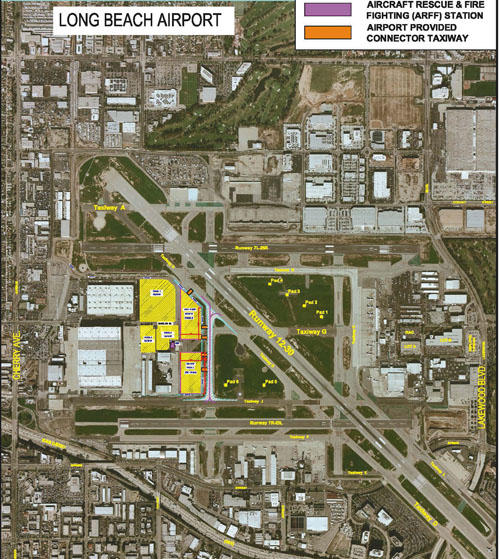On August 21, the City of Long Beach released a request for proposals (RFP) for the development of 31 acres on the west side of the airport. The RFP includes five parcels, ranging in size from 128,000 to 487,000 square feet, located east of Cherry Avenue and the 90-acre former C-17 Globemaster III site, still owned by The Boeing Company.

The City of Long Beach released a request for proposal (RFP) for the development of 31 acres of Long Beach Airport property on August 21. According to airport staff, the RFP requests proposals strictly related to aeronautical uses. The five-parcel site is located east of Wardlow Road and the 90-acre former Boeing C-17 Globemaster III site. (Map courtesy of the City of Long Beach)
“We are one of the economic engines for the city, so we hope this development will add to this and help with our economy, potentially bring jobs,” Juan Lopez-Rios, deputy director of Long Beach Airport (LGB), said. “And we hope that revitalizing that could be the start of future revitalization as Boeing starts their process of conveyance of their property or development of that property.”
The largest and northernmost parcel A is owned by the city and was formerly used by Boeing as parking for its C-17 site. Parcel C is situated directly to the north of Ross Aviation, a fixed base operator that took over the Toyota Airflite facility when the company uprooted to Texas, and borders Long Beach Fire Department Station 16 to the north and west. The parcel stretches from the Ross property to Wardlow Road and is currently leased by Ross on a month-to-month basis.
Ross currently subleases space on parcel C to three companies – Summit Aviation, Tom’s Aircraft and Aerospace International, the last of which has already vacated the building – according to Greg McQueary, general manager of Ross Aviation Long Beach. Both McQueary and Lopez-Rios said the company and airport would work with the displaced companies to find new space around the airfield.
“We are looking for aviation development, so we’re not replacing someone with a non-aeronautical use. It’s not like we have an office building that’s being leased to a printing company. If any of those tenants are displaced, we’ll work with other tenants around the airfield to try and accommodate them. Or depending on what we get, they might have a location within.”
Parcels D and E became available when two small runways were decommissioned last year. Currently, taxiway B runs through the parcels; however, it will be moved east to one of the former runways.
Lopez-Rios said proposals could be for the entire 31 acres or just certain parcels but must be for aeronautical use. He said such a large development area is rare for the airport and is an opportunity to revitalize the west side of the airfield. Development of this scale on airport property has not taken place since the construction of the Long Beach Airport Business Park and Kilroy Airport Center in the 1980s and early 1990s.
According to McQueary, Ross Aviation is making a proposal on parcel C and hopes to build hangar space large enough to accommodate two Gulfstream 650s, which he said is a missing link for larger aircraft. He added that the company is also interested in parcel E, which if developed by another company would lessen Ross’s access to the airfield, instead forcing them to taxi planes between buildings.
“The immediate change if we were to acquire that space would just turn it into additional ramp space, with long-term goals of possibly building a hangar if the needs arose. That obviously expands our ramp space by three times,” McQueary said. “That opens up the door for us to handle some of the larger aircraft that come in, especially with the NFL. The requirement is a lot larger than it is for baseball or hockey, which we already handle.”
The addition of aviation businesses to the west side of the airport would be good for Ross’s business, according to McQueary, who noted the company is the only one that sells fuel in that area. The development would clean up that part of the airport, which McQueary said has been more like a trash-covered ghost town since Boeing vacated the space.
“We’re just hoping that we can acquire the space necessary for us to grow, and we hope whoever acquires the adjacent space are friendly and good neighbors,” McQueary said.
Curt Castagna, president of the Long Beach Airport Association and president/CEO of Aerolease Group, said the development would only have positive impacts on the area. He said he knows of multiple businesses – both current LGB tenants hoping to expand and new tenants – hoping to submit proposals for the space. He denied to comment on specific businesses’ hopes of expansion.
When reviewing the proposals, Castagna said the most important factors taken into consideration should be maximizing potential job creation and enhancing surrounding airport business, as well as the surrounding off-airport community.
“There’s more to it than just putting up a building and paying rent to the city,” Castagna said. “It’s the use and the chemistry and the benefits that are going to come, not only to the existing airport environment but also the off-airport environment.”
The development is an opportunity for the airport to increase revenue streams, attract new tenants and continue the evolution of the airport to remain modern and attractive for business, Castagna added.
Proposal submissions are due by 11 a.m. on Wednesday, November 1.
